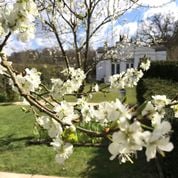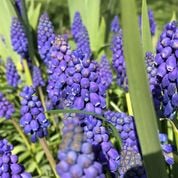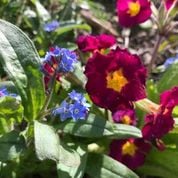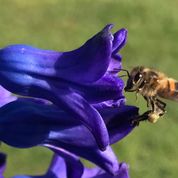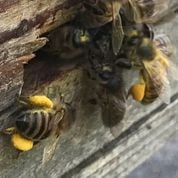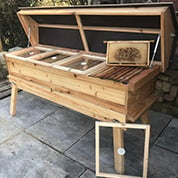Bee blog for April: looking forward to a warm and frost free spring
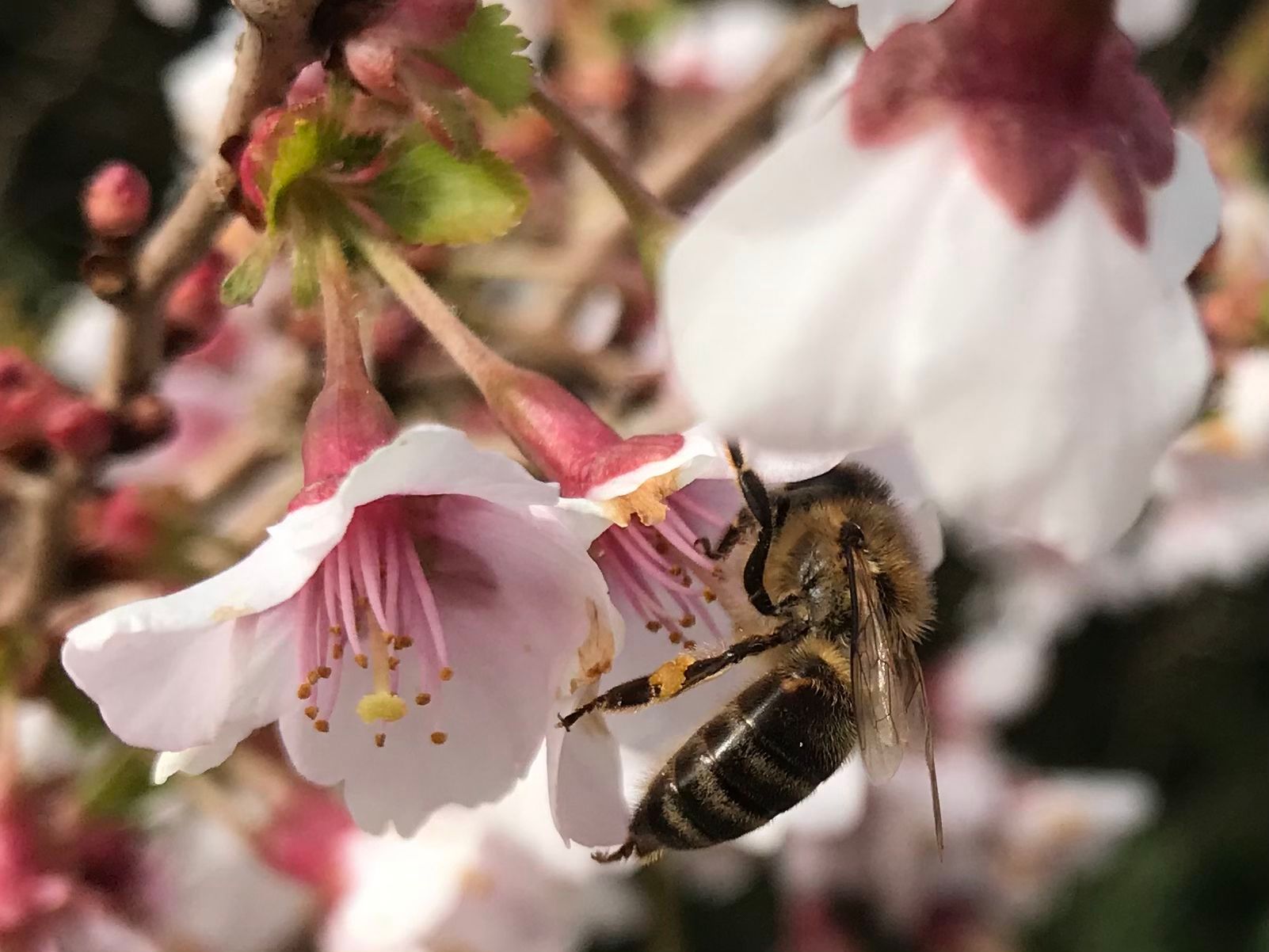
Easter Monday and the weather turned Baltic, writes our bee blogger and garden owner Colin David. As I sit at the computer tapping away, writing this April update, flurries of snow are dancing across the garden and the bees are nowhere to be seen.
The spring blossom that is out, tricked into bursting open by a few warm days last week, is unattended. Hopefully, enough of the flowers have been visited by the bees when it was a little warmer and pollination has been achieved. If so, fruit could set and all will be well so long as the forecast frosts are not too harsh. We may yet be rewarded by a crop from the early plums and plucots (plum-apricot hybrids). Here in East Surrey, the pears and apples are just preparing to bloom, fortunately still safely wrapped up by their sepals – protected from this chilly snap.
The inhabitants of the beehives have been undisturbed for six months. The first inspection of the year is always met with some trepidation. These mysterious, profound and intimate insects are creatures of continuous wonderment. The more time one spends with them the less one feels knowledgeable about their curious workings.
First inspection of 2021
What a difficult winter and early spring it has been. The brief window of warm weather at the end of March was a boon. In the garden, plants respond wonderfully to the increase in temperature. Suddenly the patches of bare earth in the herbaceous border no longer seem significant and the bees are frantically busy making the most be being able to get out and forage. The beekeeper has a welcome opportunity to carry out the first hive inspection of the year. A chance to confirm what has been observed at the entrance of the hives when it was warm enough for the bees to be working, but not sufficiently warm to have a good look inside. The rule of thumb for a hive inspection is that if it is hot enough to be working in the garden in a tee shirt, an inspection can be performed.
- Eating cherry
- Muscari and Iris
- Myosostis and primrose
- Oil seed rape
10 checks to be made during the first hive inspection of the year:
- Has the queen survived the winter? If eggs and lava can be seen all is well.
- Are there sufficient stores to support the expansion of the brood nest. Although there may be forage available in the garden a cold snap can lead to starvation at this point in the lifecycle of the honeybee.
- Check for signs of disease and varroa mite load.
- How strong is the queen? An assessment of the pattern of brood is a good indicator of the vitality of the head of the household.
- Count and keep a record of the number of frames with brood – the size of the nest.
- Check the debris on the hive floor and if possible exchange the floor for a clean one.
- Assess the quality of the brood comb and make a note of how many frames need to be replaced (it is good practice to change a third of the frames each year).
- Remove any brace comb the the bees have built over the winter.
- Assess the temperament of the colony and record any concerns if the bees are a little feisty.
- Is the hive strong enough to produce of spring honey crop? If so, be prepared to add a honey super in the coming weeks. The Oil Seed Rape (OSR) is in flower which can give an excellent honey flow.
Spring honey
The Oil Seed Rape has come into flower in our neighbouring fields. All being well the bees will produce spring honey. The OSR flowers continuously for around six weeks so is an excellent source of forage. If the OSR honey flow is “on”, the bees will focus on this opportunity, almost at the expense of other nectar sources. If you are worried about not seeing bees on your fruit trees, this could well be the reason!
- Spring pollen from hyacinth
- Pollen going into the hive
- The Long Hive
The Long Hive
The Long Hive stands ready and waiting for bees. The plan is to increase the number of hives in the Southlands Apiary from colonies containing my best queens. For me, the gauge of quality is the bee’s temperament, it is the queen bee that is exclusively responsible for the nature of the colony. As the hives are in the garden, close to the house, keeping docile bees is important. I will split the hives with the calmest bees after the OSR has finished flowering. This will serve two purposes; a swarm control method for these colonies and an increase in my hive count.
I am keen to put the Long Hive to the test. The principle of the Long Hive is that as the colony expands in the spring, the hive grows horizontally rather than vertically, as traditionally the case. The idea is that the beekeeper can manage the bees without having to lift heavy boxes and work is carried out at a comfortable height. No bending over or awkward manoeuvres are necessary; great if you have a bad back. The Long Hive is configured to house two colonies one at each end of the structure, so both can be worked at the same time, quite a novel concept. Hopefully, the Long Hive will mean quicker and more efficient inspections and improved care of the bees. We shall see over the course of the year how the technology performs. All being well the bees will respond productively to the configuration and enjoy living in their unconventional home.
As a beekeeper and a gardener one always has an eye on the weather, but never more so than now when a spring frost or protracted spell of cold weather can mean disaster for tender plants and the bees. The colonies needs to expand dramatically to make the most of the spring blossom and consequently are at their most vulnerable if they cannot get out to forage. Hopefully, the current blast of artic weather will not last too long and we can look forward to the onset of spring – proper warm and frost free spring.
The weather, although an important factor in beekeeping is just one element impacting the colony. Lessons will be learnt in the season ahead and the mystery of the bee will, once again, no doubt challenge the beekeeper.
Lead image: Bee on ornamental cherry – Prunus incisa Kojo-No-Mai. Fuji Cherry. Early flowering.
Explore our bee-friendly gardens
Find out more about our bee-blogger Colin David here





